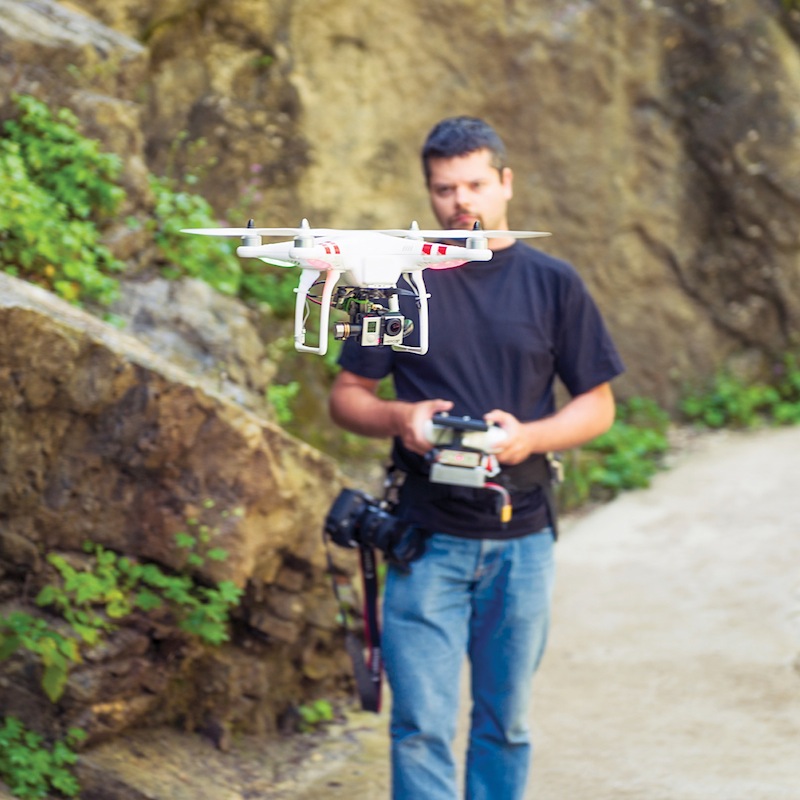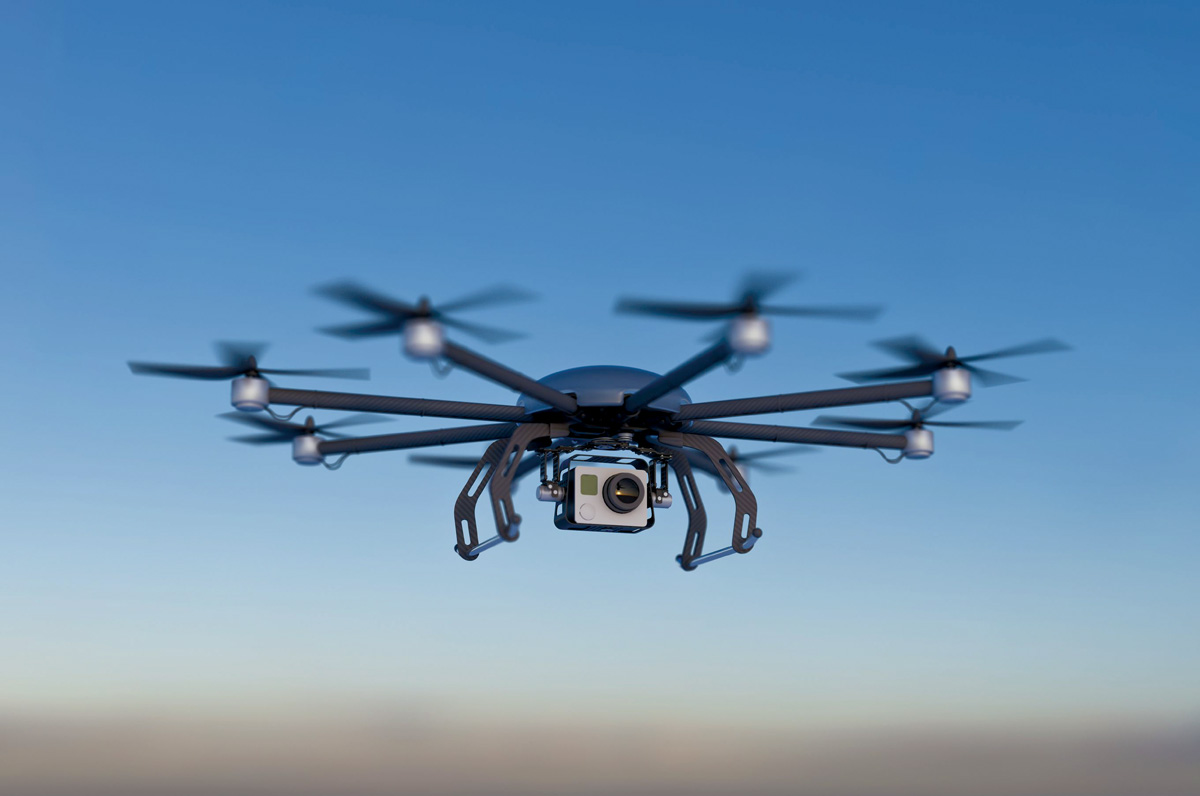The use of drones as construction tools took a big step forward on February 15, when the Federal Aviation Administration issued its Notice of Proposed Rulemaking for Small Unmanned Aircraft, which offers safety rules for drones weighing more than 55 pounds conducting non-recreational operations. And on May 6, FAA announced its Pathfinder Program, where it will work with the market to gather data to make the case for allowing drone flights for expanded commercial operations without permission.
While they wait for rules to be finalized and approved, companies wanting to fly drones are taking advantage of an exemption process that FAA streamlined last year. St. Louis-based design/build contractor Clayco, and Bechtel, North America’s largest civil engineering and construction company, are recent exemptees.
FAA is working with insurance companies to develop coverage and policy standards, says Jay Shelton, Senior Vice President and Leader of Risk Management Practice at Assurance, a Chicago-based insurance brokerage. He knows of only one carrier, Lexington Insurance, that offers a modified aviation policy covering drones.
Both Clayco and Bechtel integrate drones into their execution systems via Skycatch’s cloud-based platform for capturing data using small automonous aerial robots. Skycatch is also partnering with Komatsu, the Japanese construction equipment colossus, which in January unveiled plans to use unmanned aircraft, bulldozers, and excavators to automate early foundation work on construction sites. Komatsu intends to lease at least 200 drones from Skycatch.
FAA has estimated that between 7,500 to 20,000 drones could be permitted to fly legally by 2020. But issues around usage (such as rights of way), liability, and privacy still need to be resolved.
FAA is working with insurance companies to develop coverage and policy standards, says Jay Shelton, Senior Vice President and Leader of Risk Management Practice at Assurance, a Chicago-based insurance brokerage. He knows of only one carrier, Lexington Insurance, that offers a modified aviation policy covering drones.
Shelton believes that drone-related privacy issues in all likelihood will be sorted out by courts to determine, for example, whether an intrusion was accidental or intentional, or whether release forms are required before drones can fly over or photograph buildings or land.
“There are grey areas, but the benefits [of using drones] are unquestionable,” says Steven Lesser, Shareholder in charge of construction at the Fort Lauderdale, Fla.-based law firm Becker & Poliakoff, and Vice Chairman of the American Bar Association’s Forum on Construction Law.
 Photo: Association of Unmanned Vehicles International
Photo: Association of Unmanned Vehicles International
Lesser says AEC firms are eager to fly drones because robots make it easier and safer to access difficult areas like mining pits or rough terrain, at a fraction of what an airplane or helicopter would cost to rent.
“The possibilities are amazing,” says James Brogan, AIA, Director of Firmware Technology for Kohn Pedersen Fox Associates. His firm completed work on an airport in Nanking, China, from which Chinese construction partners sent progress reports in the form of drone-shot videos.
Wiss, Janney, Elstner Associates also is waiting for the FAA to finalize the regs on drone use, says IT Manager Raymond Jaskot. He thinks drones could be useful in high-risk construction environments where safety is problematic. Drones could also aid in measuring and inspecting buildings. Jaskot says WJE has looked into using drones with infrared cameras to detect temperature variations that could be caused by moisture trapped behind a façade.
One drone maker, France-based Sysveo, is working on software that would give drones the capability to include augmented reality 3D images in their videos, so developers could see what a building project might look like well before it exists.
“It’s critical that our technology portfolio stays ahead of the curve,” says J. Brent Williams, President of Burns & McDonnell, which began using drones in 2013, and now owns six. The firm recently entered into a partnership with Yale University to show students how drones and sensors can work in tandem. “We have the ability to switch out sensors on UAVs [unmanned aerial vehicles] from a regular camera to a near-infrared to a four-band multispectral,” says Steve Santovasi, GISP, who manages the firm’s Geospatial Services department. These options “give us the ability to visualize or categorize from bandwidths outside the limits of the human eye,” he says.
Other AEC firms see drones as enhancing their design abilities. “If you have a drone working off of a Revit model, it could show you detail areas and tie that with augmented reality as well as overlay the next construction layer,” states Robert Petty, Associate Partner at ZGF Architects, who owns a couple drones for personal use. Theoretically, he says, a designer armed with that information “could change the design on the spot with 3D printing and relay the information to robotic manufacturing.”
Peter Marchese, a Senior Consultant with Microdesk, has fed a CAD/BIM model into a drone to lay out paint lines for a building. He uses drones for reality capture to create models with Autodesk or Pix4D process imaging software. Drones could aid clash detection, too, Marchese suggests.
Marchese recommends that firms considering using drones should first train their pilots on simulation programs like Real Flight or Phoenix, and then fly the drones with two-man teams. Mark Segal, who owns the aerial photography firm Skypan, says his company always flies drones with a pilot, an assistant, and a spotter.
Segal anticipates “lots of opportunities and purposes” for drones in construction and renovation, including inspecting existing buildings. He notes that there’s been “enormous improvement” in drone stability and sophistication, and cites the new Solo drone from 3D Robotics, outfitted with a GoPro camera that an operator can control from a distance of a half-mile.
Battery technology is a concern, though. Drones use lithium polymer batteries that are sensitive to charging, and can ignite. And smaller prop drones can’t stay airborne for more than 20 minutes, tops.
Segal thinks Tesla Motors’ battery technology—its massive factory in Nevada should be fully operational by 2020—could lead to breakthroughs in battery life for UAVs. For now, he says, battery power is adequate for most AEC firms’ drone uses: “They only need to be in the air for five or six minutes at a time to get what you need.”
Next on the horizon: obstacle detection and avoidance technology, so operators can fly UAVs safely even when they’re out of sight.
MEET DRONE EXPERTS AT BUILDING HEARTLAND
Microdesk’s Peter Marchese and SkyPan’s Mark Segal will speak on “DRONES: How Design, Engineering + Construction Firms—and Their Clients—Can Benefit from Their Use” at BD+C’s Building the Heartland conference, September 1, 2015. More at: www.BuildingChicagoExpo.com.
Related Stories
| Aug 11, 2010
29 Great Solutions for the AEC Industry
AEC firms are hotbeds of invention and innovation to meet client needs in today's highly competitive environment. The editors of Building Design+Construction are pleased to present 29 "Great Solutions" to some of the most complex problems and issues facing Building Teams today. Our solutions cover eight key areas: Design, BIM + IT, Collaboration, Healthcare, Products, Technology, Business Management, and Green Building.
| Aug 11, 2010
Arup, SOM top BD+C's ranking of the country's largest mixed-use design firms
A ranking of the Top 75 Mixed-Use Design Firms based on Building Design+Construction's 2009 Giants 300 survey. For more Giants 300 rankings, visit http://www.BDCnetwork.com/Giants
| Aug 11, 2010
ASHRAE research targets tying together BIM and energy efficiency
Ensuring that a common language of “energy efficiency” is spoken by both building information modeling software used by architects and energy analysis and simulation software used by engineers is the goal of new research funded by ASHRAE.
| Aug 11, 2010
Three Opus Corporation companies file for bankruptcy
Opus Corporation, a developer headquartered in Minnetonka, Minn., filed for bankruptcy in three of its five regional operating companies: Opus East, Opus South, and Opus West. CEO Mark Rauenhorst said sharp declines in commercial real estate values and tight credit markets caused difficulties in refinancing assets and restructuring lending agreements.
| Aug 11, 2010
ZweigWhite names its fastest-growing architecture, engineering, and environmental firms
Management consulting and research firm ZweigWhite has identified the 200 fastest-growing architecture, engineering, and environmental consulting firms in the U.S. and Canada for its annual ranking, The Zweig Letter Hot Firm List. This annual list features the design and environmental firms that have outperformed the economy and competitors to become industry leaders.
| Aug 11, 2010
SSOE, Fluor among nation's largest industrial building design firms
A ranking of the Top 75 Industrial Design Firms based on Building Design+Construction's 2009 Giants 300 survey. For more Giants 300 rankings, visit http://www.BDCnetwork.com/Giants
| Aug 11, 2010
Best AEC Firms of 2011/12
Later this year, we will launch Best AEC Firms 2012. We’re looking for firms that create truly positive workplaces for their AEC professionals and support staff. Keep an eye on this page for entry information. +
| Aug 11, 2010
AAMA leads development of BIM standard for fenestration products
The American Architectural Manufacturers Association’s newly formed BIM Task Group met during the AAMA National Fall Conference to discuss the need for an BIM standard for nonresidential fenestration products.







